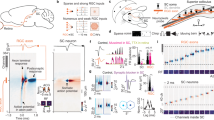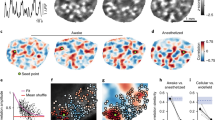Abstract
Axons of retinal ganglion cells establish orderly projections to the superior colliculus of the midbrain. Axons of neighboring cells terminate proximally in the superior colliculus thus forming a topographically precise representation of the visual world. Coordinate axes are encoded in retina and in the target through graded expression of chemical labels. Additional sharpening of projections is provided by electric activity, which is correlated between neighboring axons. Here we propose a quantitative model, which allows combining the effects of chemical labels and correlated activity in a single approach. Using this model we study a complete structure of two-dimensional topographic maps in mutant mice, in which the label encoding the horizontal retinal coordinate ephrin-A is reduced/eliminated. We show that topographic maps in ephrin-A deficient mice display a granular structure, with the regions of smooth mapping separated by linear discontinuities reminiscent of fractures observed in the maps of preferred orientation.
Similar content being viewed by others
References
Bergemann AD, Zhang L, Chiang MK, Brambilla R, Klein R, Flanagan JG (1998) Ephrin-B3, a ligand for the receptor EphB3, expressed at the midline of the developing neural tube. Oncogene 16: 471–480.
Blasdel GG (1992) Orientation selectivity, preference, and continuity in monkey striate cortex. J. Neurosci. 12: 3139–3161.
Bonhoeffer T, Grinvald A (1991) Iso-orientation domains in cat visual cortex are arranged in pinwheel-like patterns. Nature 353: 429–431.
Brown A, Yates PA, Burrola P, Ortuno D, Vaidya A, Jessell TM, Pfaff SL, O’Leary DD, Lemke G (2000) Topographic mapping from the retina to the midbrain is controlled by relative but not absolute levels of EphA receptor signaling. Cell 102: 77–88.
Cang J, Kaneko M, Yamada J, Woods G, Stryker MP, Feldheim DA (2005) Ephrin-as guide the formation of functional maps in the visual cortex. Neuron 48: 577–589.
Chklovskii DB, Koulakov AA (2004) Maps in the brain: What can we learn from them? Annu. Rev. Neurosci. 27: 369–392.
Ciossek T, Monschau B, Kremoser C, Loschinger J, Lang S, Muller BK, Bonhoeffer F, Drescher U (1998) Eph receptor-ligand interactions are necessary for guidance of retinal ganglion cell axons in vitro. Eur. J. Neurosci. 10: 1574–1580.
Connor RJ, Menzel P, Pasquale EB (1998) Expression and tyrosine phosphorylation of Eph receptors suggest multiple mechanisms in patterning of the visual system. Dev. Biol. 193: 21–35.
Constantine-Paton M, Cline HT, Debski E (1990) Patterned activity, synaptic convergence, and the NMDA receptor in developing visual pathways. Annu. Rev. Neurosci. 13: 129–154.
Contractor A, Rogers C, Maron C, Henkemeyer M, Swanson GT, Heinemann SF (2002) Trans-synaptic Eph receptor-ephrin signaling in hippocampal mossy fiber LTP. Science 296: 1864–1869.
Debski EA, Cline HT (2002) Activity-dependent mapping in the retinotectal projection. Curr. Opin. Neurobiol. 12: 93–99.
Drager UC, Hubel DH (1975) Responses to visual stimulation and relationship between visual, auditory, and somatosensory inputs in mouse superior colliculus. J. Neurophysiol. 38: 690–713.
Drescher U, Bonhoeffer F, Muller BK (1997) The Eph family in retinal axon guidance. Curr. Opin. Neurobiol. 7: 75–80.
Feldheim DA, Kim YI, Bergemann AD, Frisen J, Barbacid M, Flanagan JG (2000) Genetic analysis of ephrin-A2 and ephrin-A5 shows their requirement in multiple aspects of retinocollicular mapping. Neuron 25: 563–574.
Feldheim DA, Nakamoto M, Osterfield M, Gale NW, DeChiara TM, Rohatgi R, Yancopoulos GD, Flanagan JG (2004) Loss-of-function analysis of EphA receptors in retinotectal mapping. J. Neurosci. 24: 2542–2550.
Flanagan JG, Vanderhaeghen P (1998) The ephrins and Eph receptors in neural development. Annu. Rev. Neurosci. 21: 309–345.
Fraser SE, Hunt RK (1980) Retinotectal specificity: Models and experiments in search of a mapping function. Annu. Rev. Neurosci. 3: 319–352.
Fraser SE, Perkel DH (1990) Competitive and positional cues in the patterning of nerve connections. J. Neurobiol. 21: 51–72.
Frisen J, Yates PA, McLaughlin T, Friedman GC, O’Leary DD, Barbacid M (1998) Ephrin-A5 (AL-1/RAGS) is essential for proper retinal axon guidance and topographic mapping in the mammalian visual system. Neuron 20: 235–243.
Gale NW, Flenniken A, Compton DC, Jenkins N, Copeland NG, Gilbert DJ, Davis S, Wilkinson DG, Yancopoulos GD (1996a) Elk-L3, a novel transmembrane ligand for the Eph family of receptor tyrosine kinases, expressed in embryonic floor plate, roof plate and hindbrain segments. Oncogene 13: 1343–1352.
Gale NW, Holland SJ, Valenzuela DM, Flenniken A, Pan L, Ryan TE, Henkemeyer M, Strebhardt K, Hirai H, Wilkinson DG, Pawson T, Davis S, Yancopoulos GD (1996b) Eph receptors and ligands comprise two major specificity subclasses and are reciprocally compartmentalized during embryogenesis. Neuron 17: 9–19.
Goodhill GJ, Richards LJ (1999) Retinotectal maps: Molecules, models and misplaced data. Trends Neurosci. 22: 529–534.
Hebb DO (1949) The organization of behavior; a neuropsychological theory. Wiley, New York.
Himanen JP, Chumley MJ, Lackmann M, Li C, Barton WA, Jeffrey PD, Vearing C, Geleick D, Feldheim DA, Boyd AW, Henkemeyer M, Nikolov DB (2004) Repelling class discrimination: Ephrin-A5 binds to and activates EphB2 receptor signaling. Nat. Neurosci. 7: 501–509.
Honda H (1998) Topographic mapping in the retinotectal projection by means of complementary ligand and receptor gradients: A computer simulation study. J. Theor. Biol. 192: 235–246.
Honda H (2003) Competition between retinal ganglion axons for targets under the servomechanism model explains abnormal retinocollicular projection of Eph receptor-overexpressing or ephrin-lacking mice. J. Neurosci. 23: 10368–10377.
Hope RA, Hammond BJ, Gaze RM (1976) The arrow model: Retinotectal specificity and map formation in the goldfish visual system. Proc. R Soc. Lond. B Biol. Sci. 194: 447–466.
Hornberger MR, Dutting D, Ciossek T, Yamada T, Handwerker C, Lang S, Weth F, Huf J, Wessel R, Logan C, Tanaka H, Drescher U (1999) Modulation of EphA receptor function by coexpressed ephrinA ligands on retinal ganglion cell axons. Neuron 22: 731–742.
Kalatsky VA, Stryker MP (2003) New paradigm for optical imaging: Temporally encoded maps of intrinsic signal. Neuron 38: 529–545.
Katz LC, Shatz CJ (1996) Synaptic activity and the construction of cortical circuits. Science 274: 1133–1138.
Koonin SE (1986) Computational Physics. Addison-Wesley Pub. Co., Menlo Park, Calif.
Koulakov AA, Chklovskii DB (2001) Orientation preference patterns in mammalian visual cortex: A wire length minimization approach. Neuron 29: 519–527.
Koulakov AA, Tsigankov DN (2004) A stochastic model for retinocollicular map development. BMC Neurosci. 5: 30.
McLaughlin T, O’Leary DD (2005) Molecular gradients and development of retinotopic maps. Annu. Rev. Neurosci. 28: 327–355.
McLaughlin T, Hindges R, Yates PA, O’Leary DD (2003a) Bifunctional action of ephrin-B1 as a repellent and attractant to control bidirectional branch extension in dorsal-ventral retinotopic mapping. Development 130: 2407–2418.
McLaughlin T, Torborg CL, Feller MB, O’Leary DD (2003b) Retinotopic map refinement requires spontaneous retinal waves during a brief critical period of development. Neuron 40: 1147–1160.
Meister M, Wong RO, Baylor DA, Shatz CJ (1991) Synchronous bursts of action potentials in ganglion cells of the developing mammalian retina. Science 252: 939–943.
O’Leary DD, Wilkinson DG (1999) Eph receptors and ephrins in neural development. Curr. Opin. Neurobiol. 9: 65–73.
O’Leary DD, Yates PA, McLaughlin T (1999) Molecular development of sensory maps: Representing sights and smells in the brain. Cell 96: 255–269.
Pasquale EB (1997) The Eph family of receptors. Curr. Opin. Cell Biol. 9: 608–615.
Prestige MC, Willshaw DJ (1975) On a role for competition in the formation of patterned neural connexions. Proc. R Soc. Lond. B Biol. Sci. 190: 77–98.
Reber M, Burrola P, Lemke G (2004) A relative signalling model for the formation of a topographic neural map. Nature 431: 847–853.
Ruthazer ES, Cline HT (2004) Insights into activity-dependent map formation from the retinotectal system: A middle-of-the-brain perspective. J. Neurobiol. 59: 134–146.
Schuett S, Bonhoeffer T, Hubener M (2002) Mapping retinotopic structure in mouse visual cortex with optical imaging. J. Neurosci. 22: 6549–6559.
Shatz CJ (1996) Emergence of order in visual system development. Proc. Natl. Acad. Sci. U.S.A. 93: 602–608.
Sperry RW (1963) Chemoaffinity in the orderly growth of nerve fiber patterns and connections. Proc. Nat. Acad. Sci. U.S.A. 50: 703–710.
Swindale N (2001) Cortical cartography: What’s in a map? Curr. Biol. 11: R764–R767.
Swindale NV (1996) The development of topography in the visual cortex: A review of models. Network 7: 161–247.
Swindale NV, Matsubara JA, Cynader MS (1987) Surface organization of orientation and direction selectivity in cat area 18. J. Neurosci. 7: 1414–1427.
Tessier-Lavigne M, Goodman CS (1996) The molecular biology of axon guidance. Science 274: 1123–1133.
Tsigankov DN, Koulakov AA (2004) Can repulsion be induced by attraction: A role of ephrin-B1 in retinotectal mapping? preprint http://xxxlanlgov/abs/q-bioNC/0403013.
Whitelaw VA, Cowan JD (1981) Specificity and plasticity of retinotectal connections: A computational model. J. Neurosci. 1: 1369–1387.
Yates PA, Holub AD, McLaughlin T, Sejnowski TJ, O’Leary DD (2004) Computational modeling of retinotopic map development to define contributions of EphA-ephrinA gradients, axon-axon interactions, and patterned activity. J. Neurobiol. 59: 95–113.
Author information
Authors and Affiliations
Corresponding author
Additional information
Action Editor: Jonathan D. Victor
Rights and permissions
About this article
Cite this article
Tsigankov, D.N., Koulakov, A.A. A unifying model for activity-dependent and activity-independent mechanisms predicts complete structure of topographic maps in ephrin-A deficient mice. J Comput Neurosci 21, 101–114 (2006). https://doi.org/10.1007/s10827-006-9575-7
Received:
Revised:
Accepted:
Published:
Issue Date:
DOI: https://doi.org/10.1007/s10827-006-9575-7




